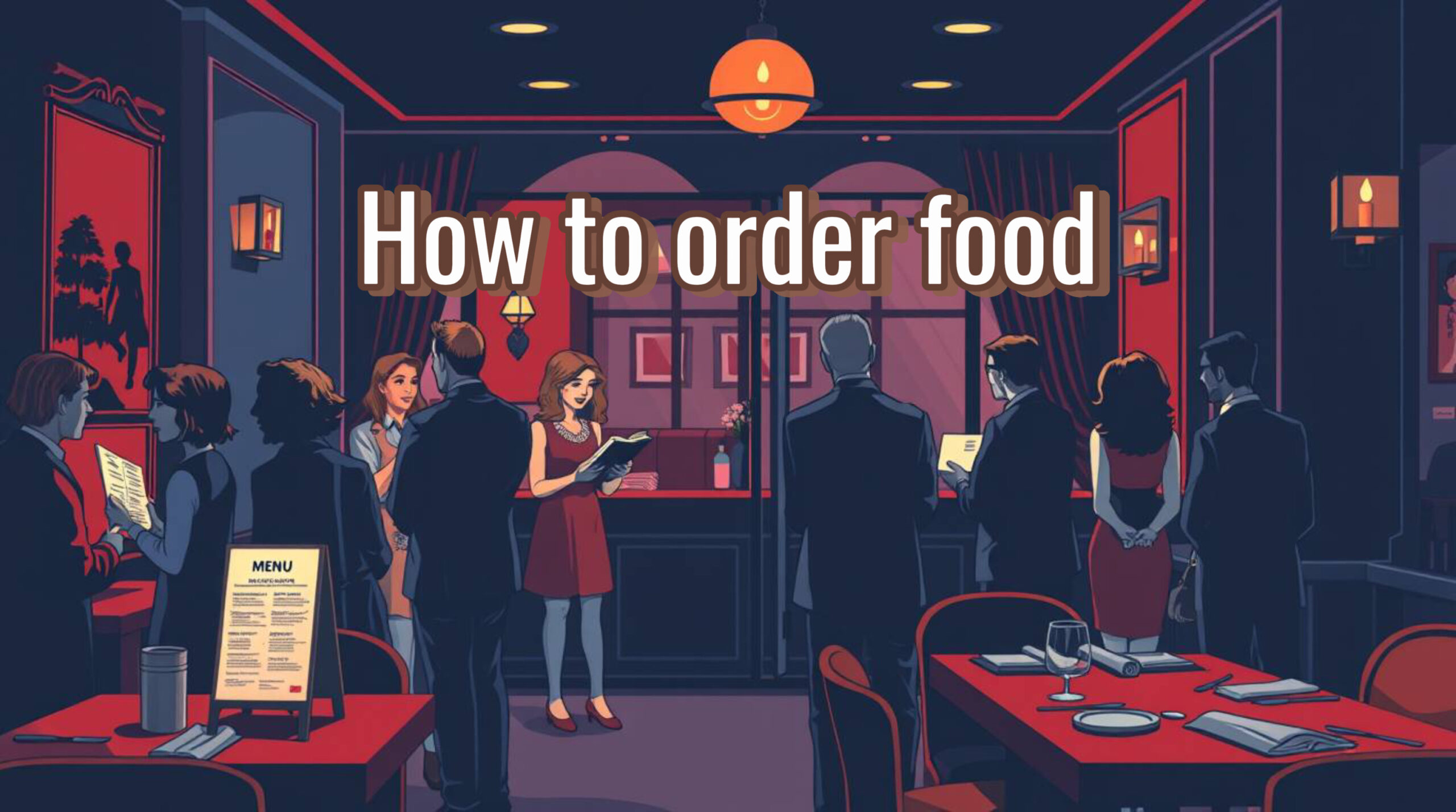Introduction
Ordering food at a restaurant is one of the most common situations you’ll encounter when traveling or living in an English-speaking country. For A1 English learners, knowing how to order food confidently can make dining out a fun and enjoyable experience. This guide will teach you essential phrases, vocabulary, and dialogues to help you order food like a pro. By the end of this post, you’ll be able to greet the server, understand the menu, place your order, and even ask for the bill—all in English!
Great! Let’s move to the next section: Basic Phrases for Ordering Food. This section will cover essential phrases for greeting the server, asking for a table, requesting a menu, and starting the conversation. Here’s the draft:

2. Basic Phrases for Ordering Food
When you enter a restaurant, the first step is to greet the server and let them know how many people are in your group. Here are some basic phrases to help you get started:
Greeting the Server
– “Hello!” or “Hi!”
– “Good morning/afternoon/evening!”
These simple greetings are polite and will make a good first impression.
Asking for a Table
– “A table for two, please.” (Replace “two” with the number of people in your group.)
– “Do you have a table for four?”
– “Can we sit by the window?” (If you have a seating preference.)
Requesting a Menu
– “Can I see the menu, please?”
– “Could we have the menu, please?”
– “Do you have an English menu?”
Starting the Conversation
– “What do you recommend?”
– “What’s the special today?”
– “Do you have any vegetarian options?”
Example Dialogue
Server: “Hello! How can I help you?”
You: “Hi! A table for two, please.”
Server: “Of course. Follow me.”
(You sit down.)
Server: “Here are your menus. Can I get you something to drink while you decide?”
You: “Yes, can I have a glass of water, please?”
Server: “Sure, I’ll be right back.”
Key Tips for Using These Phrases
- Speak Slowly and Clearly: Don’t worry about your accent—focus on being understood.
- Use Polite Words: Always say “please” and “thank you.”
- Practice Beforehand: Repeat these phrases out loud to feel more confident.

3. Understanding the Menu
When you sit down at a restaurant, the server will usually give you a menu. Understanding the menu is key to ordering the right food. Here’s a breakdown of common sections and vocabulary you’ll find on a menu:
Common Sections on a Menu
- Starters/Appetizers: Small dishes served before the main course.
– Examples: Soup, salad, bread, or bruschetta.
– Vocabulary: Soup (e.g., tomato soup), Salad (e.g., Caesar salad), Bread (e.g., garlic bread).
- Main Course: The main part of the meal.
– Examples: Pasta, steak, chicken curry, or fish and chips.
– Vocabulary: Pasta (e.g., spaghetti), Meat (e.g., beef, chicken), Seafood (e.g., salmon).
- Desserts: Sweet dishes served at the end of the meal.
– Examples: Cake, ice cream, or fruit salad.
– Vocabulary: Cake (e.g., chocolate cake), Ice cream (e.g., vanilla ice cream).
- Drinks: Beverages like water, soda, juice, or wine.
– Examples: Water, coffee, tea, or orange juice.
– Vocabulary: Coffee (e.g., black coffee), Tea (e.g., green tea), Juice (e.g., apple juice).
How to Read the Menu
– Look for the name of the dish and a short description.
– Check the price (usually listed next to the dish).
– Look for symbols or notes (e.g., 🌶️ for spicy, V for vegetarian).
Asking About Ingredients
If you have dietary restrictions or allergies, it’s important to ask about the ingredients. Here are some useful phrases:
– “Does this dish contain nuts?”
– “Is this vegetarian?”
– “Is this gluten-free?”
– “Can you make it less spicy?”
Example Dialogue
You: “Excuse me, does the chicken curry contain nuts?”
Server: “No, it doesn’t. Would you like to order it?”
You: “Yes, please. And can I have it without onions?”
Server: “Of course. I’ll let the kitchen know.”
Key Tips for Understanding the Menu
- Take Your Time: Don’t rush. Read the menu carefully.
- Ask Questions: If you don’t understand something, ask the server.
- Learn Basic Food Vocabulary: Practice words for common foods and drinks.

4. How to Order Food
Ordering food at a restaurant can feel overwhelming, but with these simple steps, you’ll be able to do it confidently. Let’s break it down:
Step 1: Ask for Recommendations
If you’re unsure what to order, ask the server for suggestions. Here are some useful phrases:
– “What do you recommend?”
– “What’s the most popular dish?”
– “Do you have any specials today?”
Step 2: Placing Your Order
When you’re ready to order, use these phrases:
– “I’d like the chicken curry, please.”
– “Can I have the spaghetti carbonara?”
– “I’ll take the grilled salmon.”
Step 3: Making Special Requests
If you have dietary restrictions or preferences, don’t hesitate to ask:
– “Can I have it without onions?”
– “Can you make it less spicy?”
– “Is it possible to have the sauce on the side?”
Step 4: Confirming Your Order
After placing your order, the server might repeat it back to you. Listen carefully and confirm:
– Server: “So, that’s one chicken curry and one glass of water. Is that correct?”
– You: “Yes, that’s right.”
Example Dialogue
Server: “Are you ready to order?”
You: “Yes, I’d like the chicken curry, please.”
Server: “Would you like it with rice or naan?”
You: “With rice, please. And can I have it without onions?”
Server: “Of course. Anything else?”
You: “No, that’s all. Thank you.”
Handling Common Situations
- If You Change Your Mind:
– “Actually, can I change my order to the pasta instead?”
– “Sorry, I’d like to cancel the soup and order a salad instead.”
- If You Don’t Understand Something:
– “Could you repeat that, please?”
– “I’m sorry, I didn’t understand. Can you explain?”
- If the Food Isn’t What You Expected:
– “Excuse me, I ordered the chicken curry, but this is beef.”
– “This dish is too spicy. Can I have something else?”
Key Tips for Ordering Food
- Be Polite: Always say “please” and “thank you.”
- Speak Clearly: Don’t rush. Take your time to pronounce the words correctly.
- Practice Common Phrases: Rehearse ordering food at home to build confidence

5. Asking Questions About the Food
When ordering food, it’s important to ask questions to ensure the dish meets your preferences or dietary needs. Here are some common questions and phrases you can use:
1. Questions About Portion Size
If you’re unsure how much food you’ll get, ask:
– “How big is the portion?”
– “Is this enough for two people?”
– “Is this a main course or a starter?”
2. Questions About Spiciness
If you’re sensitive to spicy food, ask:
– “Is this dish spicy?”
– “Can you make it less spicy?”
– “Does it have chili or pepper?”
3. Questions About Cooking Style
If you’re curious about how the food is prepared, ask:
– “Is this grilled or fried?”
– “Is the chicken baked or roasted?”
– “Can I have the fish steamed instead of fried?”
4. Questions About Ingredients
If you have allergies or dietary restrictions, ask:
– “Does this contain nuts?”
– “Is this dish vegetarian?”
– “Is there dairy in this?”
Example Dialogue
You: “Excuse me, is the pasta dish spicy?”
Server: “It has a little chili, but we can make it mild for you.”
You: “Yes, please. And does it contain cheese?”
Server: “Yes, it has Parmesan cheese. Would you like it without cheese?”
You: “No, that’s fine. Thank you!”
Key Tips for Asking Questions
- Don’t Be Shy: It’s okay to ask questions to make sure the food is right for you.
- Be Specific: Clearly explain what you need (e.g., “less spicy,” “no nuts”).
- Listen Carefully: Pay attention to the server’s answers to avoid misunderstandings.

6. During the Meal
Once your food arrives, you might need to interact with the server for various reasons. Here are some common situations and phrases to help you during the meal:
1. Requesting Something
If you need something during the meal, use these phrases:
– “Can I have more water, please?”
– “Could I get some extra napkins?”
– “Excuse me, can I have some ketchup?”
2. Complimenting the Food
If you enjoy the food, let the server know:
– “This is delicious!”
– “The pasta is amazing!”
– “Thank you, the food is great!”
3. Reporting a Problem
If there’s an issue with your food, politely inform the server:
– “Excuse me, this isn’t what I ordered.”
– “The soup is cold. Can you heat it up, please?”
– “I think there’s a mistake. I ordered the vegetarian dish.”
4. Asking for the Bill
When you’re ready to leave, ask for the bill:
– “Can we have the bill, please?”
– “Could you bring the check, please?”
– “We’re ready to pay.”
Example Dialogue
You: “Excuse me, can I have some more water, please?”
Server: “Of course. I’ll bring it right away.”
(Later)
You: “This pasta is delicious! Thank you.”
Server: “I’m glad you like it! Is there anything else you need?”
You: “No, we’re ready for the bill, please.”
Server: “Sure, I’ll bring it right over.”
Key Tips for During the Meal
- Be Polite: Always use “please” and “thank you.”
- Speak Clearly: Make sure the server understands your request.
- Stay Calm: If there’s a problem, explain it politely and calmly.
7. Vocabulary List
Here’s a list of essential food-related vocabulary, organized by category. Practice these words to improve your confidence when ordering food in English.
1. Types of Food
– Starters/Appetizers: Soup, salad, bread, bruschetta, fries.
– Main Course: Pasta, steak, chicken, fish, pizza, burger, curry, rice, noodles.
– Desserts: Cake, ice cream, fruit salad, chocolate, pie, pudding.
– Vegetables: Carrot, potato, tomato, onion, lettuce, cucumber.
– Fruits: Apple, banana, orange, strawberry, grape, watermelon.
2. Drinks
– Water, coffee, tea, juice, soda, wine, beer, milk, lemonade.
3. Cooking Methods
– Grilled, fried, baked, roasted, steamed, boiled, sautéed.
4. Common Ingredients
– Salt, pepper, sugar, butter, oil, cheese, garlic, chili, sauce.
5. Utensils and Tableware
– Fork, knife, spoon, plate, bowl, glass, napkin, cup.
6. Useful Adjectives
– Spicy, sweet, sour, salty, hot, cold, fresh, crispy, soft.
Example Sentences Using Vocabulary
– “I’d like the grilled chicken with a side of fries, please.”
– “Can I have a glass of orange juice?”
– “Is the pasta spicy?”
– “This cake is sweet and delicious!”
Key Tips for Learning Vocabulary
- Practice Daily: Use flashcards or apps to memorize new words.
- Use in Sentences: Try to use the words in simple sentences.
- Review Regularly: Go over the vocabulary list often to remember it better.

8. Practice Dialogues
Here are some example dialogues to help you practice ordering food in different situations. Read them aloud and try to memorize the key phrases.
Dialogue 1: Ordering at a Café
Server: “Hello! What can I get for you today?”
You: “Hi! Can I have a cappuccino and a blueberry muffin, please?”
Server: “Sure. Would you like the cappuccino hot or iced?”
You: “Hot, please.”
Server: “Anything else?”
You: “No, that’s all. Thank you!”
Server: “Okay. Your total is $8.50.”
(You pay and wait for your order.)
Server: “Here’s your cappuccino and muffin. Enjoy!”
You: “Thank you!”
Dialogue 2: Ordering at a Fast Food Restaurant
Server: “Welcome to Burger World. What would you like to order?”
You: “Hi! I’d like a cheeseburger and small fries, please.”
Server: “Would you like a drink with that?”
You: “Yes, a medium soda, please.”
Server: “Is that for here or to go?”
You: “To go, please.”
Server: “Your total is $7.25.”
(You pay and wait for your order.)
Server: “Here’s your order. Have a great day!”
You: “Thank you!”
Dialogue 3: Ordering at a Fine Dining Restaurant
Server: “Good evening! Do you have a reservation?”
You: “Yes, under the name Smith.”
Server: “Ah, yes. Follow me, please.”
(You sit down.)
Server: “Here’s the menu. Can I get you something to drink while you decide?”
You: “Yes, a glass of water, please.”
Server: “Of course. I’ll be right back.”
(Later)
Server: “Are you ready to order?”
You: “Yes, I’d like the grilled salmon and a side of mashed potatoes, please.”
Server: “Excellent choice. Would you like anything else?”
You: “No, that’s all. Thank you.”
Server: “Your food will be ready shortly.”
(After the meal)
You: “Can we have the bill, please?”
Server: “Of course. Here you go.”
You: “Thank you. The food was delicious!”
Server: “I’m glad you enjoyed it. Have a wonderful evening!”
Key Tips for Practicing Dialogues
- Role-Playing: Practice with a friend or family member.
- Record Yourself: Listen to your pronunciation and improve.
- Use Real-Life Situations: Try ordering food in English at a restaurant or café.
9. Tips for Practicing
Practicing is the key to becoming confident in ordering food in English. Here are some tips to help you improve:
1. Role-Playing
– Practice with a Friend: Pretend to be a customer and a server. Use the dialogues from this post as a guide.
– Switch Roles: Take turns being the server and the customer to practice different phrases.
2. Use Language Apps
– Duolingo or Babbel: These apps have lessons on food and restaurant vocabulary.
– HelloTalk or Tandem: Chat with native English speakers and practice ordering food.
3. Watch Videos
– YouTube Tutorials: Watch videos of people ordering food in English. Pay attention to their pronunciation and phrases.
– TV Shows or Movies: Watch scenes set in restaurants to hear natural conversations.
4. Visit Restaurants
– Start Small: Visit a café or fast food restaurant where the ordering process is simple.
– Practice Phrases: Use the phrases you’ve learned, like “Can I have…?” or “I’d like….”
– Ask for Help: If you’re unsure, politely ask the server to repeat or explain.
5. Build Vocabulary
– Flashcards: Create flashcards with food-related words and practice daily.
– Label Items at Home: Stick labels on food items in your kitchen to learn their names in English.
6. Record Yourself
– Practice Speaking: Record yourself ordering food and listen to the recording. Identify areas to improve.
– Compare with Native Speakers: Listen to how native speakers pronounce words and try to mimic them.
7. Be Patient and Persistent
– Don’t Be Afraid to Make Mistakes: Mistakes are part of learning. Keep practicing!
– Celebrate Small Wins: Every time you successfully order food in English, celebrate your progress.
Example Practice Routine
- Day 1–2: Learn basic phrases and vocabulary.
- Day 3–4: Practice dialogues with a friend or in front of a mirror.
- Day 5–6: Visit a restaurant and order in English.
- Day 7: Review what you’ve learned and set new goals.
10. Conclusion
Congratulations! You’ve learned how to order food at a restaurant in English, from basic phrases to understanding the menu, placing your order, and handling common situations. Let’s recap what you’ve achieved:
- Basic Phrases: You now know how to greet the server, ask for a table, and request a menu.
- Understanding the Menu: You can identify common sections on a menu and ask about ingredients.
- Ordering Food: You’ve practiced placing your order, making special requests, and confirming your order.
- During the Meal: You’ve learned how to request something, compliment the food, and ask for the bill.
- Vocabulary: You’ve expanded your food-related vocabulary with words for dishes, drinks, and cooking methods.
- Practice Dialogues: You’ve seen real-life examples of ordering food in different scenarios.
- Tips for Practicing: You’ve gained practical advice on how to practice and improve your skills.
Keep Practicing!
– Use What You’ve Learned: Visit a restaurant or café and order in English. Don’t be afraid to make mistakes—every attempt is a step forward.
– Set Goals: Challenge yourself to learn new phrases or try ordering in different types of restaurants.
– Stay Consistent: Practice regularly to build confidence and fluency.
Final Encouragement
Ordering food in English is a valuable skill that will make your dining experiences more enjoyable and stress-free. With the phrases, vocabulary, and tips from this post, you’re well on your way to becoming a confident English speaker. Keep practicing, and soon you’ll be ordering like a pro!
Call to Action
If you found this post helpful, share it with other English learners or leave a comment below with your favorite phrase or tip. And don’t forget to check out our other posts for more English learning resources!




